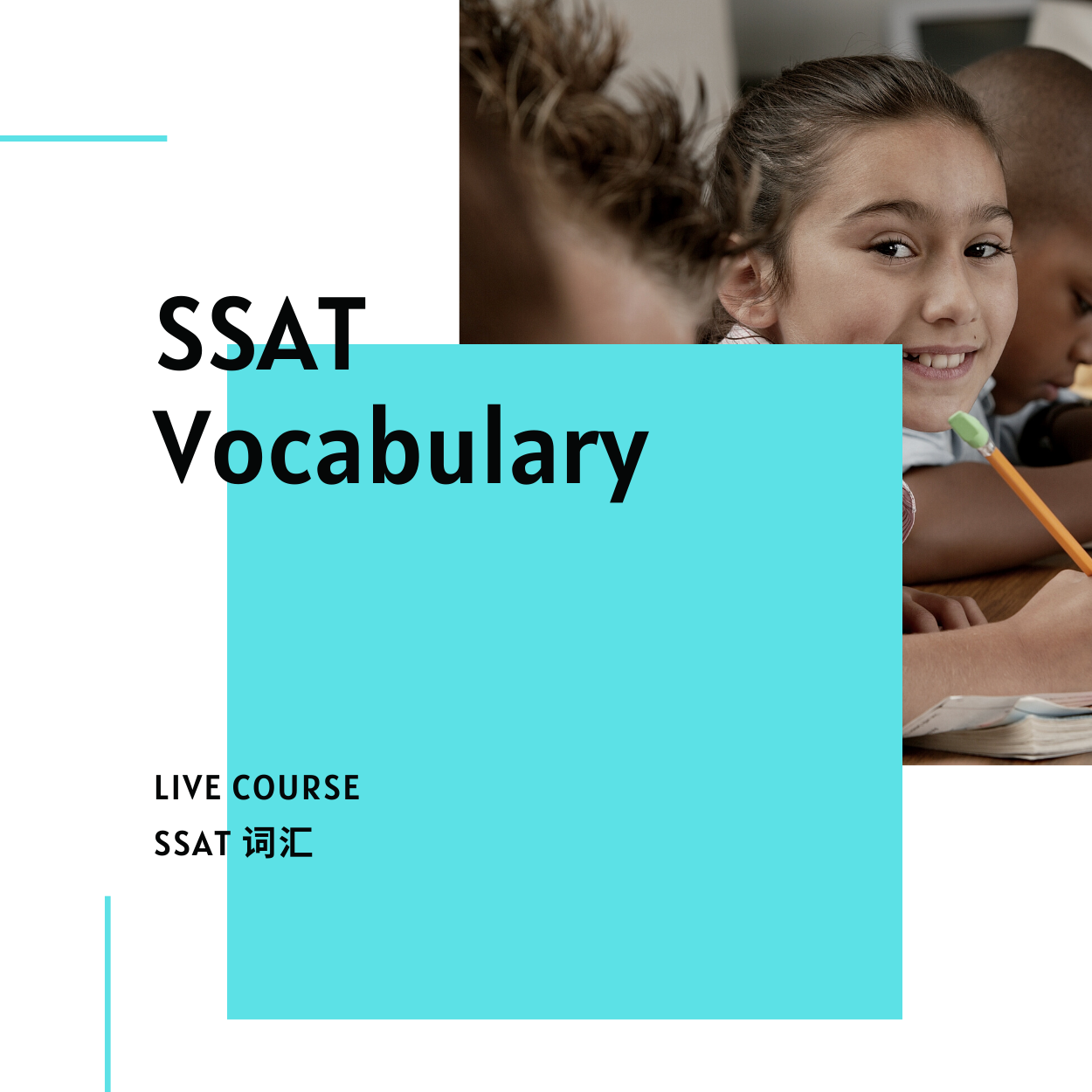Do not overlap with the vocabulary section offered in SSAT/SAT advanced courses; Test-prep vocabulary courses primarily focus on the precise application of vocabularies in both readings and writings; solve issues such as fail to incorporate appropriate words in writings, as well as to tackle the commonly seen problems of reading inefficiencies.
Date and Time
- July 5, 2021 to July 30, 2021
- Every Mondays, Tuesdays, Wednesdays, Thursdays, Fridays
- 9:00 AM ~ 11:00 AM
Suitable For
- Grade 5 ~ Grade 7
Learning Objectives
- learn scientific and effective methods of memorizing vocabulary based on linguistics
- differentiate synonyms and antonyms
- build relationship of analogy
- figure out contextual meaning in reading
- improve on word choices in writing
SSAT FAQ
SSAT is a significant entrance test for private high schools in the United States and Canada. It was founded in 1957 by SSATB (Secondary School Admission Test Board) in Princeton, New Jersey, USA. Since the inception of the SSAT, there have been more than 750 test centres worldwide, and registration is closed three weeks before the test. The SSAT test usually has two levels: Middle Level and Upper Level. Middle Level is for students in grades 5 to 7; Upper Level is for students in grades 8 to 11.
SSAT mainly measures students' mathematics, English proficiency, and comprehension. The test is divided into four parts: Mathematics (Quantitative), Language (Verbal), Reading (Reading), and Composition (Writing); it is divided into Middle-level and Upper-level. For students below G5, the school does not require SSAT. They only need to participate in the school's assessment and interview.
Middle-level scores for each subject are between 440 points and 710 points, with a full score of 2130 points and the minimum score is 1320 points. Upper-level scores for each subject are between 500 and 800 points, with a total score of 2400 points and a minimum score of 1500 points. Writing samples are not scored and sent directly to the school where the student chooses to apply. It is one of the crucial references for the school to select students.
The ideal time is to start 1 year in advance. The biggest challenge for most candidates is the vocabulary in the beginning of SSAT prep, so they need to start early to memorize advanced words, know the word family, and practice application in reading and writing. All of these are the focus of Kate Language SSAT Foundation course. Then students get into the SSAT Advanced course when they will learn test-taking strategies. Finally SSAT Crash course is to help students take a leap in the SSAT test, which is usually scheduled from October to November.
SSAT percentage is where the student is compared to all other candidates of the same age and sex in the world in the past three years. The higher the percentage, the more outstanding (1%-99%).
Many private schools in Toronto accept international students' applications, but the University of Toronto School only accepts students with citizenship or permanent residency status. The vast majority of top private schools require applicants to take the SSAT test for Grade 9+ entrance, only Appleby School does not require this score for native English-speaking students who complete the application before October 31 each year. Therefore, if you want to study in a private high school in Toronto, you must take the SSAT test. If you successfully pass the test, you've won the first step of entering a renowned American university.
Approximately 300 private high schools worldwide require that students applying for admission must have SSAT scores, and more than 300 schools will prioritize applicants who provide SSAT scores. SSAT scores are more important especially when applying for the boarding option, as the school will judge the students' English proficiency based on their SSAT scores. Also, learning SSAT can help students adapt to the North American education and test system early. It can help students improve their English proficiency, adapt to education and test modes, and lay a solid foundation for obtaining high SAT scores in the future and entering first-class American schools.
Since 2010, when applying for the SSAT, students can send their scores to the school. Parents need to pay attention to the fact that the school will see that you have taken the SSAT several times this year and quickly know the weighted score and percentage each time. If you have taken multiple exams in the current test year (August-July of the following year), your official transcript will indicate that you have taken numerous exam results.
If the school accepting the scores is interested, they can verify your scores on other exams during the year. You don't have to send other official transcripts (including essays) to the school, but these schools can view the weighted scores and percentages for horizontal comparison or verification. Many schools indicate that they are interested in the student's highest score in several exams. They assume that if an applicant has taken the exam multiple times but only sends one transcript to the school, this score is the highest. The scores of several tests will not be combined or averaged, and each student's SSAT scores are independent and integral. Tests not taken will not be reported to the school.
In the SSAT test, although writing is not scored, there are three points that parents and candidates must pay attention to
- Each candidate's writing paper will be directly sent to the designated private school so that the private school Admission Officer can evaluate the writing level by himself/herself.
- The writing is significant to admissions officers, and most private schools arrange writing exams when interviewing applicants on campus.
- When the applicant officially submits the application materials, if the writing level in the application document is inconsistent with the applicant's writing content in the private school assessment, it will create an integrity crisis.


